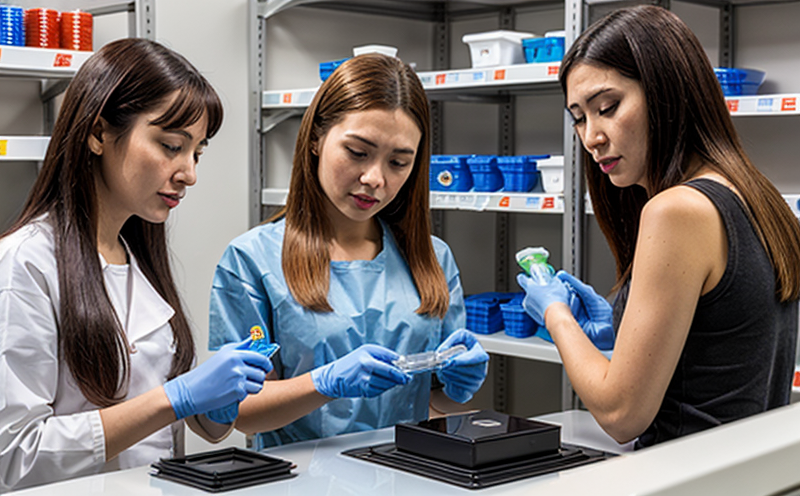IEC 62631 Dielectric Properties Testing of Consumer Plastics
The International Electrotechnical Commission (IEC) Standard IEC 62631 provides a framework for testing the dielectric properties of consumer plastics, which is crucial in ensuring their suitability for use in various electrical and electronic applications. This standard aims to assess how well these materials can withstand high-voltage stresses without degrading or failing.
The test method described in IEC 62631 involves subjecting a specimen cut from the plastic under test to alternating current (AC) voltage while monitoring its behavior over time. Key parameters include capacitance, loss angle tangent (tan δ), and dissipation factor (DF). These metrics help determine if the material can maintain its integrity when exposed to electrical fields, which is particularly important for products like household appliances, electronics, and medical devices.
Dielectric testing is not just about measuring physical properties; it also evaluates a plastic's ability to insulate against unwanted currents. This is especially critical in environments where safety and reliability are paramount. By adhering to IEC 62631 standards during development stages, manufacturers can ensure that their products meet both internal quality control requirements and external regulatory expectations.
The process typically begins with selecting an appropriate sample size based on the intended application of the plastic component being tested. Specimens must be prepared according to specified dimensions outlined in the standard, ensuring uniformity across all samples within a batch. Once prepared, they are placed into a specially designed test chamber where controlled environmental conditions like temperature and humidity can be maintained.
During testing, an AC voltage is applied between two electrodes positioned relative to the sample. The current flowing through the material is measured continuously throughout the experiment. From these measurements, engineers calculate capacitance (C), which represents the ability of a capacitor to store electrical energy; loss angle tangent (tan δ), indicating energy dissipation as heat during oscillatory motion; and dissipation factor (DF), reflecting overall dielectric losses within the sample.
Interpreting results involves comparing them against specified limits set forth in IEC 62631. Compliance with these values demonstrates that the plastic meets safety standards necessary for its intended use. Non-compliance may indicate issues such as poor insulation performance, increased risk of short circuits, or potential hazards related to electrical shock.
By employing rigorous testing procedures aligned with IEC 62631 guidelines, organizations can gain competitive advantages by producing safer and more reliable products. Additionally, adherence to international standards fosters trust among consumers who know they are receiving high-quality goods from reputable manufacturers committed to maintaining strict quality controls throughout production processes.
Why It Matters
The importance of IEC 62631 dielectric testing cannot be overstated, especially in today's fast-evolving consumer electronics industry. As new materials continue to emerge and existing ones evolve, it becomes increasingly essential for businesses to stay abreast of evolving standards.
- Ensures safety: By accurately measuring capacitance, loss angle tangent, and dissipation factor, this testing method helps identify potential risks associated with exposed high-voltage systems.
- Promotes reliability: Consistent compliance ensures that products perform reliably under varying conditions, enhancing customer satisfaction and brand reputation.
- Facilitates innovation: Understanding dielectric properties allows for the development of novel materials tailored specifically to meet stringent performance requirements specified by IEC 62631.
In conclusion, implementing thorough testing protocols based on IEC 62631 is vital not only for regulatory compliance but also for maintaining a competitive edge in an ever-changing market landscape.
Why Choose This Test
Selecting the correct type of dielectric testing is crucial when working with consumer plastics. Here are some reasons why IEC 62631 stands out:
- International Recognition: Being an international standard, it ensures consistency and reliability across different countries and regions.
- Comprehensive Coverage: It covers a wide range of consumer plastics used in various applications, providing detailed insights into their dielectric characteristics.
- Scientific Rigor: The methodology is based on sound scientific principles, ensuring accurate and repeatable results.
- User-Friendly: Clear instructions and guidelines make it accessible even to those without extensive technical expertise.
In summary, choosing IEC 62631 for dielectric property testing ensures that your products meet the highest quality standards while being safe for end users.
Competitive Advantage and Market Impact
- Differentiation: Adhering to IEC 62631 can differentiate your company from competitors by demonstrating a commitment to safety and quality.
- Innovation: The insights gained through this testing process can inspire new product designs that push the boundaries of what is possible with current materials.
- Consumer Trust: Compliance with international standards builds trust among consumers, encouraging repeat purchases and positive word-of-mouth referrals.
- Regulatory Approval: Meeting these stringent requirements increases the likelihood of regulatory approval, opening doors to new markets.
In today's competitive marketplace, having a robust testing protocol in place can be a significant factor in achieving success. By investing time and resources into ensuring compliance with IEC 62631, you position yourself ahead of others who may not prioritize similar standards.





